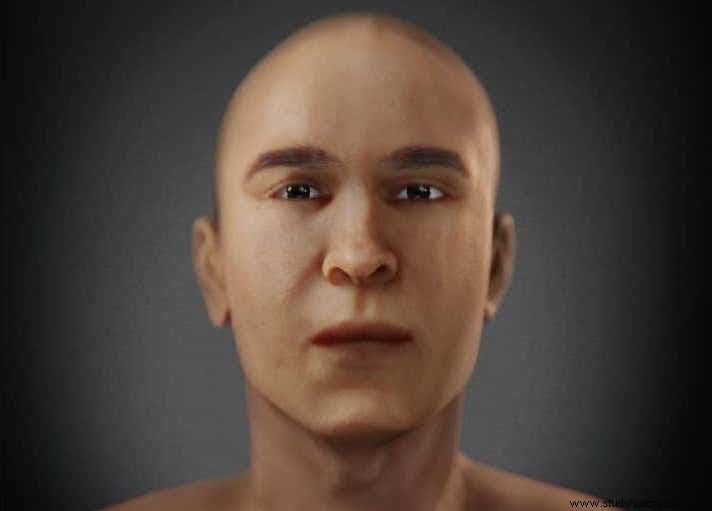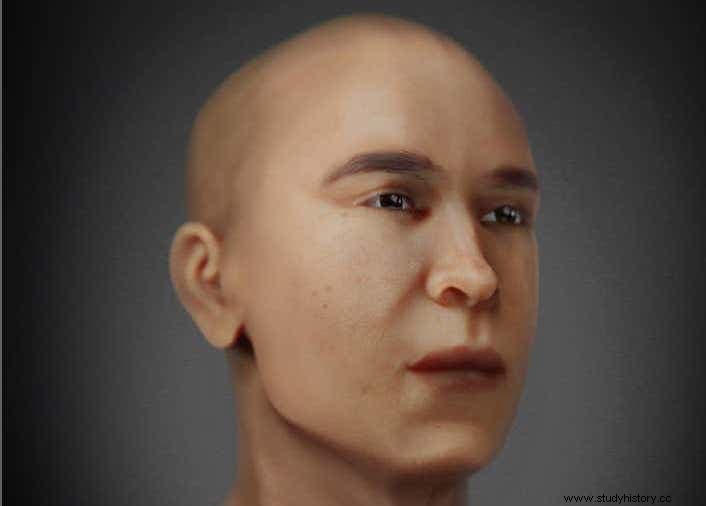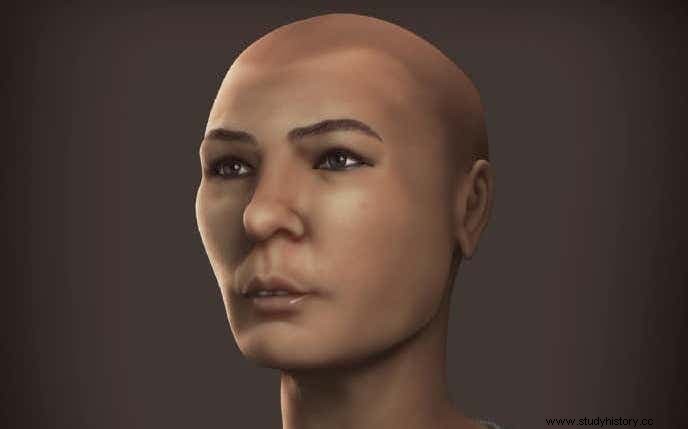Scientists at the FAPAB Research Center in Sicily (Forensic Anthropology, Paleopathology and Bioarchaeology) have spent the last few months creating a novel facial reconstruction of the mysterious mummy, now skeletonized, from tomb KV 55 in the Valley of the Kings.
Under the direction of the director of the FAPAB, Francesco M. Galassi (physician and paleopathologist), and the coordinator of Egyptological studies, Michael E. Habicht (Egyptologist and mummy specialist), a new facial reconstruction was created from the data collected previously by the Brazilian expert Cicero Moraes, recognized throughout the world for his facial reconstructions.
In the past, Mr. Moraes collaborated with FAPAB in the reconstruction of the face of the Greek skull attributed to Sophocles in the 19th century and that of Princess Baqt of the 18th dynasty of Egypt.

To achieve this result, the team, which also included the forensic anthropologist and deputy director of FAPAB, Elena Varotto, re-analyzed the published literature on the KV 55 skeleton and an extensive set of photographs and videos to obtain the maximum anatomical details and applied the methods used in today's forensic facial reconstructions.
Why is this important?
- The mummy KV 55 (CG 61075 from Cairo) was found in 1907 and has since sparked a controversial investigation. The problem lies in his anthropological age at the time of death and the resulting identification.
- The morphology already suggested a close relationship with Tutankhamun. Genetic tests have determined that the KV 55 mummy is the genetic father of Tutankhamun, although in 2010 some of these genetic results were criticized by experts on paleomolecules.
- Historical and Egyptological research has attributed this skeleton to the heretic Pharaoh Akhenaten, the first monarch to develop monotheism, which was also a political move to strip the powerful priestly "caste" of its control over the Nile lands. However, his revolution was short-lived and the old order was restored.
- Anthropological research has in some cases raised problems regarding the attribution, in the sense that the skeleton belongs to an individual of about 20 years, which could constitute a chronological problem with the supposed age at death of Akhenaten (about 40 years). However, it should be noted that the historical evidence for the length of Akhenaten's reign and life is very fragmentary and there are several, often contradictory, theories.
- This facial reconstruction metaphorically brings to life one of the most controversial and important mummies in world history, potentially attributable to Akhenaten himself, though further confirmation of this identification might be desired.
- Following this initial report on facial reconstruction, the team will finalize the publication of a full anthropological study to be submitted to a respected international peer-reviewed journal for consideration.
Historical background
The mummy was found in a secondary burial in the undecorated tomb KV 55 in the Valley of the Kings, a few meters from the tomb of Tutankhamun. The tomb furnishings were a wild mix of objects that had belonged to different people from the Amarna period, a reliquary of Queen Teje, a feather-patterned coffin belonging to Kiya, Akhenaten's concubine, and, secondly, jars Kiya's canopies, also reworked for Akhenaten.

In addition, magical bricks bearing the names of Akhenaten were found. The most enigmatic figure of the late Amarna period -Semenejkara- is not clearly attested in the tomb.
The mummy disintegrated into mummy dust and bones under the hands of excavators Ayrton and Davis, so that today only a skeleton remains. The width of the pelvis led Davis to the erroneous conclusion that the person buried was a woman and he went so far as to publicize the find as the tomb of Queen Tyje.
Australian scientist Grafton E. Smith, then Egypt's leading anthropologist, examined the skeleton and concluded that it was clearly that of a male individual. Based on archaeological finds, he identified him as Akhenaten. This was so despite the fact that his age, around 26, was too low for an identification with Akhenaten, who is said to have reigned for 17 years and may have fathered his first daughter Meritaton in the first year of his reign. .
Later anthropologists have in part classified the mummy as even younger and thus suggested an identification with Semenejkara. The mysterious figure of Semenejkara appears alongside Akhenaten in the last years of his reign.
Another research theory, which has been gaining currency since the mid-1970s, sees Semenejkara in an entirely different way:is she the famous queen Nefertiti who succeeded Akhenaten in the fictional male role of Pharaoh Semenejkara and reigned as king for some years? This would mean that Semenejkara as a man would not exist at all and therefore the identification of the KV 55 skeleton as Semenejkara would be completely impossible.
The whole debate was elevated to a sensational level in 2015 by British Egyptologist C. Nicholas Reeves, who, backed by good arguments, theorized that Nefertiti was buried as yet undiscovered as Semenejkara behind the north wall of Tutankhamun's tomb. .
Medical and anthropological data
Numerous anthropological features leave no doubt that the KV 55 is a male. Genetics has also confirmed it. Morphologically and genetically, he appears to be the father of Tutankhamun. However, the genetic results are complicated by the fact of sibling marriage practiced in the royal family. KV 55's teeth are somewhat more worn than Tutankhamun's, but less so than King Amenhotep III's (KV 55's father).

On the basis of anthropological data, in particular the fusion of the epiphyses and the stage of the symphysis pubis, an age between adolescent and young adult, 19 to 22 years, can reasonably be proposed, as previously suggested by Strouhal. Such an age at death is problematic to reconcile with Akhenaten's reign, unless a longer co-regency of a minor Akhenaten next to his father is assumed.
Such coregency of about 8 years has gained more support in recent years among experts. A few months ago, FAPAB reconstructed another mummy, which could possibly be a daughter of KV 55. Mummy CG 61076, traditionally labeled "Baqt", is a possible candidate for Meritaten, Ankhesenamun or Beketaten.
A first attempt at facial reconstruction dates back to 1966, but royal scarves were added to the head, which however gives the wrong impression. In our reconstruction we dispensed with any jewelry or hairstyle and chose to focus on the real look.
